After finishing this piece, I learned of the passing of a great pillar of the Canadian Baha’i community, not to mention an internationally renowned painter. His name was Otto Donald Rogers, “Don” to most who knew him. He was a quietly magnificent human being, and I’d like to retroactively offer this as a small tribute to a great man. Peace to his family and friends.
[12-minute read]
A rather different (shorter) version of this piece appears at the Baha’i Teachings website: click here for Part 1, here for Part 2.
Maybe you’ve been obsessing about the NHL or NBA playoffs. (No Canadian teams left in the quest for the hockey grail. No LeBron, no more Spurs.) Or wondering if spring will ever come. (Spoiler: it will. It’s underway. Just ask flood victims all over everywhere, but don’t mention climate change. That would be rude!) But for the Baha’is, it’s coming near the end of the “Most Great Festival” of the Baha’i calendar, and I’m all in.
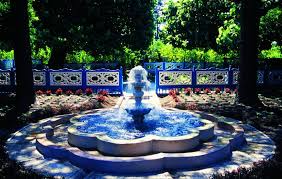
This is not the original Najibiyyih Garden that Baha’u’llah called Paradise, but it evokes the same spirit.
This festival is called “Ridván”, an Arabic word meaning “paradise”, and the best my Canadian mouth can manage is something like ‘Rez-VAHN’. It’s a 12-day period that celebrates the public “mission statement” of the Faith’s founder, Bahá’u’lláh, in a Baghdad garden in 1863. This Persian nobleman, already stripped of wealth and social status and banished from his homeland, was turning a supposedly humiliating further exile into, well, a mighty big party now celebrated by millions around the globe. It’s Day 11. Two nights ago I prayed and partied with a small group not far from my house. I’ll do it again tomorrow night on Day 12, but on April 21, I joined in with a big crowd of Baha’is and their friends for the Big Ridvan Opening, where we were invited to consider how the Baha’i community got from 1863 Baghdad obscurity to the world-wide reach it has today. I’ve been trying to follow Baha’u’llah’s mighty System of knowledge and practice for a long time now. Sometimes it feels I haven’t gotten very far, but I’m still walking, and the Baha’i Big Picture is bright and ever-developing.
Anyway, it all got me thinking about histories: my own, that of the Baha’i community over the past century and a half, and even of earlier crossings into New Millennium territory.
And I thought: I would have made a very poor 1st– or 2nd-century Christian. I would’ve wanted the Kingdom to come NOW! But the growth of Christianity was slow, and the times were confusing. Heck, Pope Gregory wouldn’t be born for centuries, so the Gregorian calendar that dates our lives based on Jesus’s life hadn’t been invented; 100 years after Christ, the word “Christian” was just beginning to distinguish this tiny community from the many other Jewish cults and sects that had arisen. Even 300 years after the life of Jesus Christ, His followers were found only in tiny pockets in what we call the “Middle East”¹, Turkey, northern Africa and southern Europe, basically within a few donkey-days journey of the Mediterranean Sea. They were just beginning to organize their scriptures and get their doctrines and dogmas together, 325 years after Christ’s life, and the Christians wouldn’t become a major population even in the Mediterranean region until the 6th century. Today, it’s the most widespread religion in the world, of course, and we all take its supernatural degree of influence and prestige for granted. But I would have been so impatient as an early Christian!
¹ Ever noticed how Eurocentric that term is? As if everyplace should be measured from London or Paris (which, for many centuries, it was.)
So listen: when I joined the Baha’i community as a 1970s teenager, I began to wonder, Why are other faith groups, often younger than we are, seeming to grow so much faster than we are? I was noticing the Hare Krishna chants on Toronto streets, or the sudden North American splash, in news media and in recruitment, of the Unification Church, the so-called “Moonies”. I wasn’t tempted to join them, or even emulate their methods, but their bursts of public prominence bugged me. A wise Baha’i elder answered our youthful questions in his deep, heavily accented but utterly logical way. (If you want to channel the voice of Dr. Danesh, imagine American diplomat Henry Kissinger, but with a Persian rather than a German accent, and with a devotion to the psychology of peace and justice rather than to strategies of conflict.) He calmly explained it this way: Think about what we are trying to grow. If you look at two plants in their first season of growth – one of them a pumpkin, one of them an oak tree – your conclusion might be easy. The pumpkin is obviously more impressive, vines and bright flowers and, within months, gigantic orange fruits! Meanwhile, the oak looks like a tender, fruitless twig. The community of Baha’u’llah is growing like an oak tree; as impressive as pumpkins seem to be, at the end of a year you have a few pumpkin pies and maybe a rotting jack-o-lantern, and that’s it.
That made sense to me then. (The reference to pie and jack-o-lanterns is probably mine, but you get the point.) There must have been a host of movements, 1900 years ago, that would have soundly defeated the Christians on a “Most Likely To Succeed” ballot. But the followers of Jesus, in the above analogy, were a slow-growing but eventually mighty oak tree, not a flash-in-the-pumpkin-pie-pan. I still have a lot to learn about patience, but the evolution of the Baha’i community, from its quietly intimate beginnings in the rose-coloured Garden of Ridvan to what I see now, is enough – barely – to keep me hopeful and sane. It’s over 150 years since Baha’u’llah announced his mission in Baghdad, which isn’t as long ago as our present-focussed obsessions and shortening attention spans can make it seem. His writings confidently predicted the growth of world-wide attention to his teachings and of the community that would arise in his name:
It is incumbent upon all the peoples of the world to reconcile their differences, and, with perfect unity and peace, abide beneath the shadow of the Tree of His care and loving-kindness….Soon will the present-day order be rolled up, and a new one spread out in its stead.
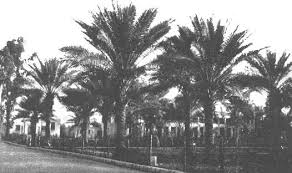
The original “Ridvan” garden, on the shores of the Tigris River in Baghdad. There were roses, roses and nightingales, and joy.
Ridvan now feels like a mighty Declaration, but back then even an attentive neutral observer might have missed the planting of that seed. Baha’u’llah confirmed publicly, to only a few people, what many of his family and friends had quietly known: that he was the one who would lead us to the long-promised day of peace and justice. He thus transformed his upcoming banishment into his modern community’s greatest festival. So how did we get HERE from back THERE? The Baha’is then were few in number, decimated by persecution, and frankly their fellowship seemed like a rather hopeless little twig. I seized on five pivotal years in the steady, seemingly unspectacular growth of the Baha’i community into the beautiful young tree it is today. Here is annual snapshot number one:
1892. My father’s parents were young, and would soon meet each other. It’s a little over 125 years since then, the year when Baha’u’llah passed away, leaving his son and family and a still-tiny band of followers to carry on the astounding, world-changing mission he had described and put into motion. Baha’u’llah (an Arabic term, meaning “splendour/light of God”) was not much more widely known than Jesus Christ (“the anointed one”) had been on the cross. His son, ‘Abdu’l-Baha, still a prisoner of the Turkish empire, was left to encourage and inspire a few thousand believers, in a few Middle Eastern countries, to live as his father had prescribed, and to tell the world of Baha’u’llah’s message of world peace, world unity, and the essential oneness of humanity. Good luck with that, folks! But listen: they began.
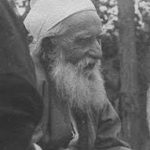
His given name was Abbas, but he only wanted to be known as “servant” of Baha’u’llah and of humankind.
1912. My father turned two that year. It’s a little over a century since ‘Abdu’l-Baha, having been released from prison a few years before, travelled to Europe and North America. The Baha’i Master spoke of a great global transformation, both spiritual and material, in Paris and Montreal, Chicago and Los Angeles, and hundreds more places. Two world wars were looming. Nowhere in the world did women even have the right to vote anywhere on earth. Corrupted religious institutions and a colonial system still oppressed most of the planet’s peoples. And yet, ‘Abdu’l-Baha spoke of the elimination of all prejudices, the equality of women and men, and the coming of age of the entire human race. Imagine! There were a few handfuls of Baha’is in all of Europe and North America. That’s a pretty small tree, even if it *IS* going to be an oak!
1936. It’s a little over 8 decades since the successor of ‘Abdu’l-Baha, Shoghi Effendi, explained how the teachings of Baha’u’llah were to be applied and sketched out humanity’s glorious future. Some believers had thought, after the passing of ‘Abdu’l-Baha, that Shoghi Effendi should call for the formation of the Universal House of Justice, a global institution that Baha’u’llah had ordained in his writings. Shoghi Effendi, still only in his 30s but fully the Guardian of the Baha’i Faith, said this, in effect: That is not how growth works. A tree needs roots and a strong trunk before it can give shelter and fruit. We are nourishing the roots of the system. He explained all of this in an epic series of letters, collected and published as The World Order of Baha’u’llah. It envisions and elaborates how a united humanity will operate. My parents were youth then; they had never heard of the Faith. But by then several thousand followers were living in 40 countries, and more than that lived in Iran, where the Faith was born. Over 100 cities had Spiritual Assemblies, and ten countries had communities substantial enough to elect National Spiritual Assemblies. These remarkable Baha’i institutions are formed through a kind of spiritual democracy that the world can still barely imagine. Baha’i literature existed in 40 languages. The tree was growing, but with another World War coming, how many even knew it was there?
1963. A little over 50 years back, I was in grade 1 with the terrifying Mrs. Williamson. The Baha’i community, a century after Ridvan, had reached another stage of growth in response to crisis. The Guardian Shoghi Effendi, beloved guide of the Faith’s global expansion, had died. A council of internationally respected believers, convened to help determine the community’s course, did two amazing and unprecedented things. First, they willingly, even eagerly, renounced their authority. In 1963 more than 50 countries had National Spiritual Assemblies, which Shoghi Effendi had referred to as the necessary pillars that would support the eventual formation of the Universal House of Justice. The second act of these custodians was to call for the nine members of each of these national bodies to elect the House to guide the Baha’i world. The Faith’s roots were deep on every continent, and its sacred Writings were available in hundreds of languages. Now, via the planet’s first global election, the World System envisioned by Baha’u’llah was basically established. Slowly, slowly, humanity began to turn its eyes towards the Baha’i world centre, and the vision of hope that is embodied there. The tree was young, but it was spreading its branches more and more widely.
1995. Almost 25 years ago, I married the lovely Diana; more important, a new stage of delight and possibility and growth was also underway in the Baha’i world. We now had nearly 200 National Spiritual Assemblies, well over 100,000 local communities, over 800 languages in which Baha’u’llah’s message could be read, and millions of believers. Now, said the Universal House of Justice, it was time for this organically developing world fellowship to “emerge from obscurity”, to boldly look outward, and to offer shelter and service beyond the limits of our membership. The Baha’i community – incredibly diverse, now the second most widespread Faith in the world, principled yet flexibly learning and growing and, most remarkably, absolutely united – wrote to the United Nations Organization, praising it for its 50 years of accomplishments and advising as to how it could improve and develop. What’s more, the House of Justice offered the Baha’i community to the world as a model. Here, they said, is an example to inspire the entire human race in pursuit of its fondest hopes: global peace, justice and equality. Here is how you can put into practice the ideal of the oneness of humanity. It was a little terrifying, honestly! There is no triumphalism, that’s for sure; the Baha’is don’t shout Mission Accomplished! or claim that they’ve got everything figured out. They know that they have lots of growth and learning ahead of them, and all like-minded folk are welcome to join in! After all, fewer than one in a thousand humans is currently working at The Baha’i Way, and the task of building a united humanity is gargantuan. But look how far we’ve come, from the seed planted by Baha’u’llah during those magical 12 days in 1863!
As a young man, I was challenged to think of the Baha’i community as playing The Long Game, as an oak tree rather than some wild annual profusion of vines and county-fair prize-winning mega-gourds. And now it’s 2019, and I think it’s safe to say: this ain’t no pumpkin! The youthful Baha’i tree needs all of us to nourish its growth, but it bears rich and progressive fruits, has borne all the storms that have tried to uproot it, and it increasingly embraces and consoles innumerable others. But in the end, maybe this analogy is imperfect; if you look, you can see a whole forest of symbiotic Baha’i communities. This is what galvanizes me, what allows me to believe in – because I can see it – the human race’s ability to grow anew, even among the million ways we’ve worked to mess up our planetary home.
There’s a lot going on, friends. Some of it serves to alienate, distract and disillusion us, to make us feel that time is running out and there’s no REASON for all this, beyond just getting yours. But at the very same time, there are wonderful but less boisterous streams, events that inexorably draw us closer together, which unite and strengthen and stimulate us to believe that there’s an endgame. There is a gorgeous and worthy human goal. After all my words, Baha’u’llah says it better in only a few:
“Let your vision be world-embracing, rather than confined to your own selves….Let your thoughts be fixed upon that which will rehabilitate the fortunes of mankind…”
That’s what the Baha’is are working on.

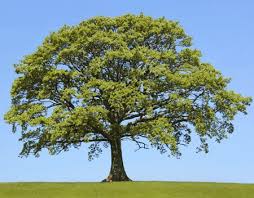
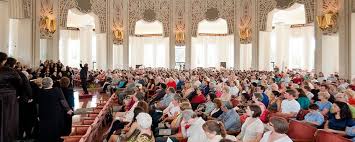
Exemplary piece of writing, my friend. In my opinion, your best work is when you are writing about the Faith. I would love to read a memoir of your life from Haldimand to Ottawa to China and beyond. I am sure you have many stories and thoughts that would inspire believers. I’ve been a Baha’i for 20 years. I still struggle with the concepts of “teaching and service” but I know I could learn a lot from your example.
I hope to catch up with you and Diana this Summer (with Mike I hope) at a friendly neighbourhood diner.
I love your writing. We need to catch up! When are y’all coming down?!